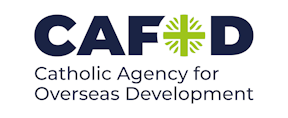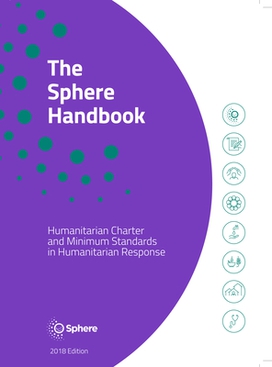Related Research Articles

Humanitarian aid is material and logistic assistance, usually in the short-term, to people in need. Among the people in need are the homeless, refugees, and victims of natural disasters, wars, and famines. The primary objective of humanitarian aid is to save lives, alleviate suffering, and maintain human dignity.

The Catholic Agency for Overseas Development, commonly known as CAFOD, is an international development and relief charity. It is the official aid agency of the Catholic Church in England and Wales.

A humanitarian crisis is defined as a singular event or a series of events that are threatening in terms of health, safety or well-being of a community or large group of people. It may be an internal or external conflict and usually occurs throughout a large land area. Local, national and international responses are necessary in such events.

Islamic Relief Worldwide is a faith-inspired humanitarian and development agency which is working to support and empower the world's most vulnerable people.

Medair is an international non-governmental organisation (INGO) whose purpose is to relieve human suffering in some of the world's most remote and devastated places. Medair aims to assist people affected by natural disasters and conflict to recover with dignity through the delivery of quality humanitarian aid.
There are a number of meanings for the term humanitarian. Here, humanitarian pertains to the practice of saving lives and alleviating suffering. It is usually related to emergency response whether in the case of a natural disaster or a man-made disaster such as war or other armed conflict. Humanitarian principles govern the way humanitarian response is carried out.

Sphere is a global movement started in 1997 aiming to improve the quality of humanitarian assistance. The Sphere standards are the most commonly used and most widely known set of core humanitarian standards. Sphere's flagship publication is The Sphere Handbook.

Humanitarian Accountability Partnership International, established in 2003, was the humanitarian sector's first international self-regulatory body. A multi-agency initiative working to improve the accountability of humanitarian action to people affected by disasters and other crises, HAP members ranged from organisations with a mandate for emergency relief and development activities to institutional donors. The organisation aimed to strengthen accountability towards those affected by crisis situations and to facilitate improved performance within the humanitarian sector. The ultimate goal of the organisation was to uphold the rights and the dignity of crisis-affected populations across the world.
Sexual exploitation and abuse in humanitarian response first came to public attention with the release of a report in February 2002 of a joint assessment mission examining the issue. The joint mission reported that "refugee children in Guinea, Liberia and Sierra Leone have been subjected to sexual abuse and exploitation, reportedly by employees of national and international NGOs, UNHCR and other UN bodies..." Humanitarian agencies responded almost immediately with measures designed to prevent further abuse, setting up an inter-agency task force with the objective of "strengthening and enhancing the protection and care of women and children in situations of humanitarian crisis and conflict..." In 2008 there were signs that sexual exploitation and abuse of beneficiaries not only continued, but was under-reported. In January 2010, the ECHA/ECPS task force developed a website devoted to protection from sexual exploitation and abuse (PSEA) by personnel of the United Nations (UN), non-governmental organizations (NGOs) and other international organizations.
ACT Alliance is a global alliance of more than 145 churches and related organisations from over 120 countries created to provide humanitarian aid for poor and marginalized people. 76% of its member organisations are rooted on the global south, 22% in the global north and 2% have a global presence.
ISO 31000 is a family of international standards relating to risk management codified by the International Organization for Standardization. The standard is intended to provide a consistent vocabulary and methodology for assessing and managing risk, resolving the historic ambiguities and differences in the ways risk are described.
Humanitarian Initiative Just Relief Aid (HIJRA) is an African humanitarian organization focused on the implementation of emergency and resilience programming in the greater Horn of Africa, Somalia, Kenya, and Uganda.
People In Aid was an international, not-for-profit membership organisation with offices in the UK, Australia and East Africa. People In Aid no longer exists following its merger with HAP International on 9 June 2015 to form the CHS Alliance.
The Emergency Capacity Building Project is a collaborative capacity-building project aimed at improving the speed, effectiveness and delivery of humanitarian response programs. The ECB Project is a partnership between seven non-governmental organizations (NGOs), and implements programs in one region and four countries known as consortia.

The United Nations World Humanitarian Summit (WHS) was held in Istanbul, Turkey, on May 23 and 24, 2016. The summit was an initiative of the Secretary-General of the United Nations Ban Ki-moon and was organized by the United Nations Office for the Coordination of Humanitarian Affairs.
Common Operational Datasets or CODs, are authoritative reference datasets needed to support operations and decision-making for all actors in a humanitarian response. CODs are 'best available' datasets that ensure consistency and simplify the discovery and exchange of key data. The data is typically geo-spatially linked using a coordinate system and has unique geographic identification codes (P-codes).
ACAPS is a non-profit, non-governmental project that provides international, independent humanitarian analysis. Founded in 2009, ACAPS provides daily monitoring and analysis of the situations in 150 countries, to support humanitarian aid workers. This analysis is freely provided to the NGOs, UN agencies and donors. ACAPS is also known for having developed a severity ranking of humanitarian crises. It employs around 30 professionals based in Geneva.
The Core Humanitarian Standard Alliance, known as the CHS Alliance, is a network of non-governmental organizations working in humanitarian aid.

The Grand Bargain: Agenda for Humanity, usually called the Grand Bargain, is an agreement to reform the delivery of humanitarian aid, that was struck at the World Humanitarian Summit in May 2016. The agreement contains 51 specific commitments, grouped into ten focus areas, with activity targets to be completed by January 1, 2020.

The Sphere Handbook: Humanitarian Charter and Minimum Standards in Humanitarian Response often called the Sphere Standards is a textbook of minimum standards in humanitarian aid published by the Sphere Association.
References
- ↑ "Home Page - CHS". corehumanitarianstandard.org. Retrieved 2018-01-23.
- ↑ "The Core Humanitarian Standard to launch on 12 December". reliefweb. reliefweb. Retrieved 15 April 2016.
- ↑ "Launch of a Stronger Standard". chsalliance.org. Retrieved 2024-01-05.
- ↑ Purvis, Katherine (2015-06-11). "Core Humanitarian Standard: do NGOs need another set of standards?". the Guardian. Retrieved 2018-01-23.
- ↑ "Strengthening humanitarian response through the application of a common standard: The Core Humanitarian Standard on Quality and Accountability" (PDF).
- ↑ "Who We Are" . Retrieved 2018-01-23.
- ↑ "Groupe URD - Our mission". www.urd.org. Archived from the original on 2018-01-24. Retrieved 2018-01-23.
- ↑ "The Sphere Project | The Sphere Project in brief | About". www.sphereproject.org. Retrieved 2018-01-23.
- ↑ "The Standard". corehumanitarianstandard.org. Retrieved 2024-01-05.
- ↑ "Statements of support - CHS". corehumanitarianstandard.org. Archived from the original on 2021-08-02. Retrieved 2018-01-23.
- ↑ "Case study: Transforming surge capacity through training" (PDF).
- ↑ "The People First Impact Method" (PDF).
- ↑ "Seven ways to help curb corruption in the humanitarian sector" . Retrieved 2018-01-23.
- ↑ "Developing the PSEA Handbook – what we learnt" . Retrieved 2018-01-23.
- ↑ "Verification" . Retrieved 2018-01-23.